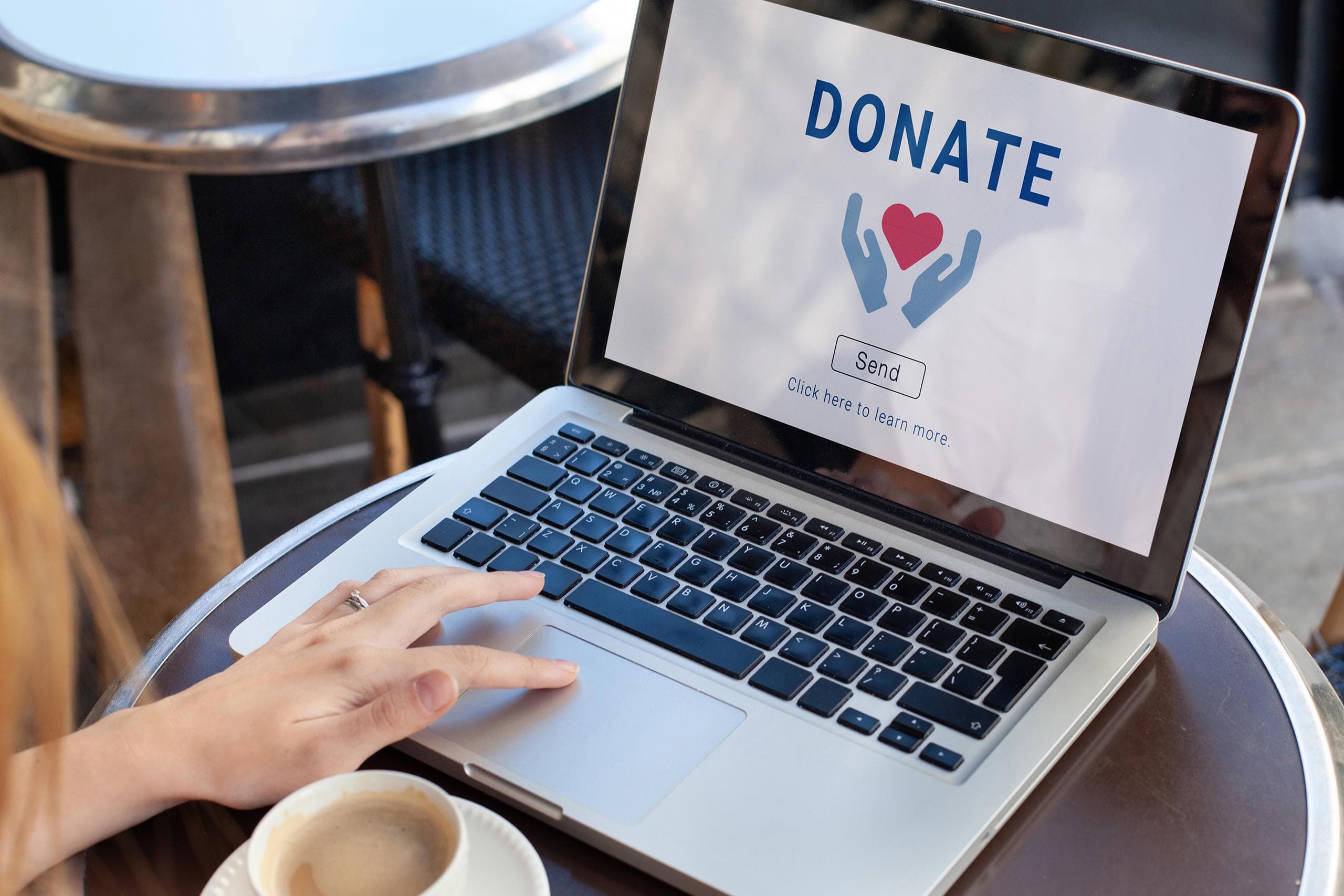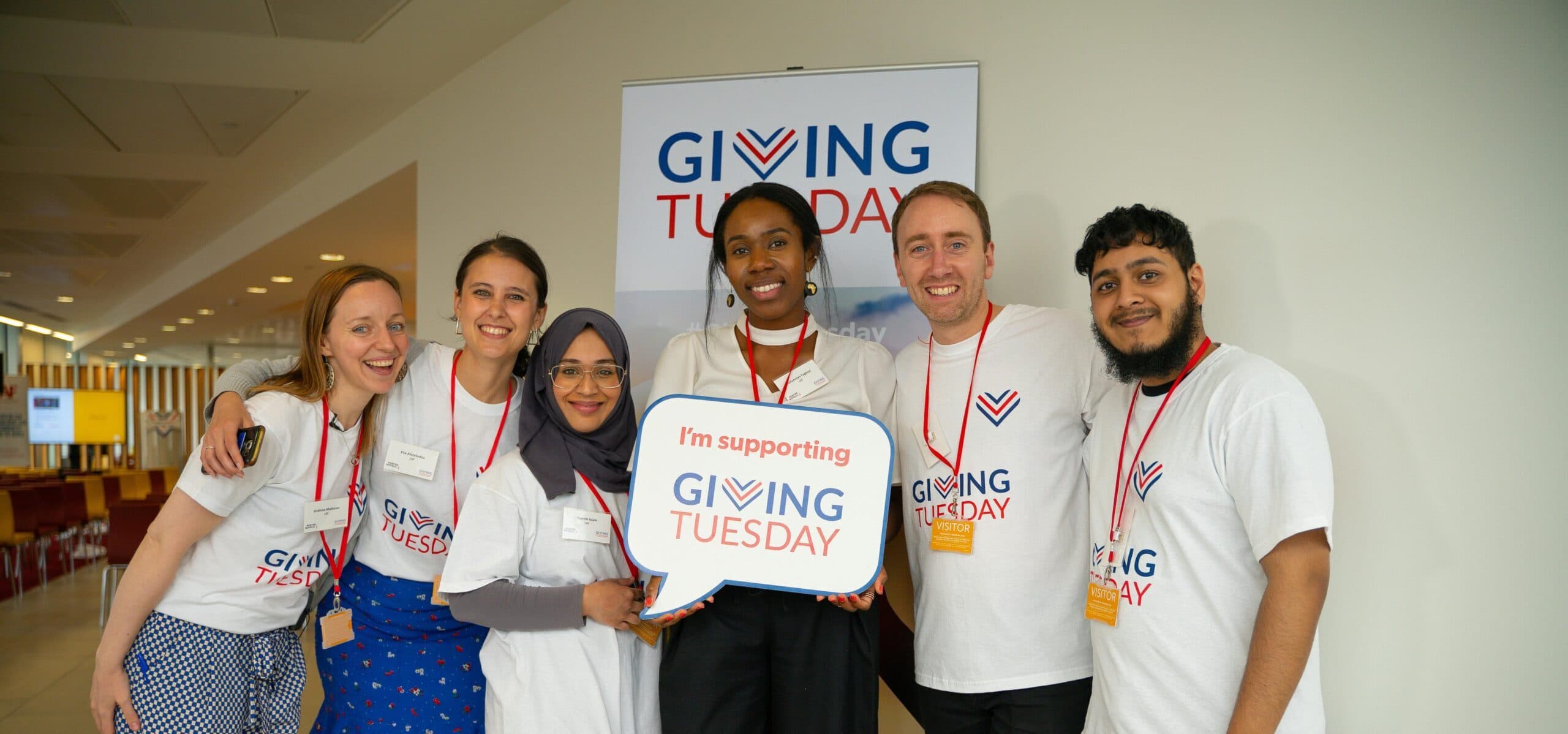
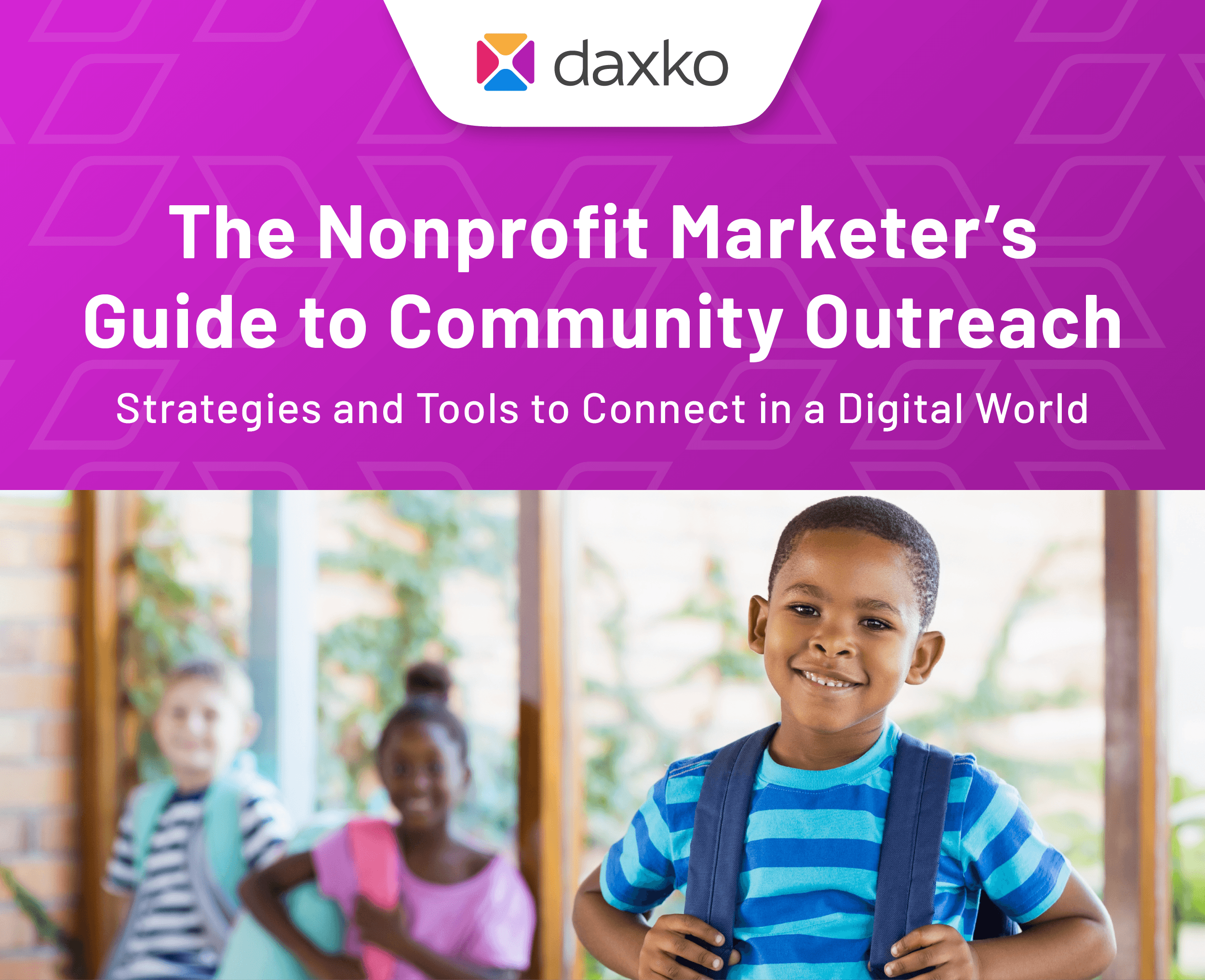
Giving Tuesday, held on the Tuesday following Thanksgiving, is a global day of giving that provides nonprofits with a unique opportunity to amplify their mission, engage supporters, and drive impactful change. For nonprofit community centers, it’s a pivotal moment to rally donors, foster community spirit, and raise crucial funds to sustain vital programs.
Whether you’re a seasoned fundraiser or planning your first Giving Tuesday campaign, having the right strategy—and the right tools—can make all the difference. This Giving Tuesday Toolkit equips you with actionable tips to prepare, execute, and follow up on your campaign, ensuring success now and setting the stage for future growth.
Why Giving Tuesday Matters for Nonprofit Community Centers
As a nonprofit community center, your mission is to serve and uplift your local community. Giving Tuesday is a chance to:
- Tell your story: Share the impact your organization has on the community.
- Engage donors: Deepen relationships with existing supporters and attract new ones.
- Build momentum: Kickstart year-end fundraising efforts and set the tone for 2025.
With limited resources and competing priorities, preparation is key to maximizing this opportunity.
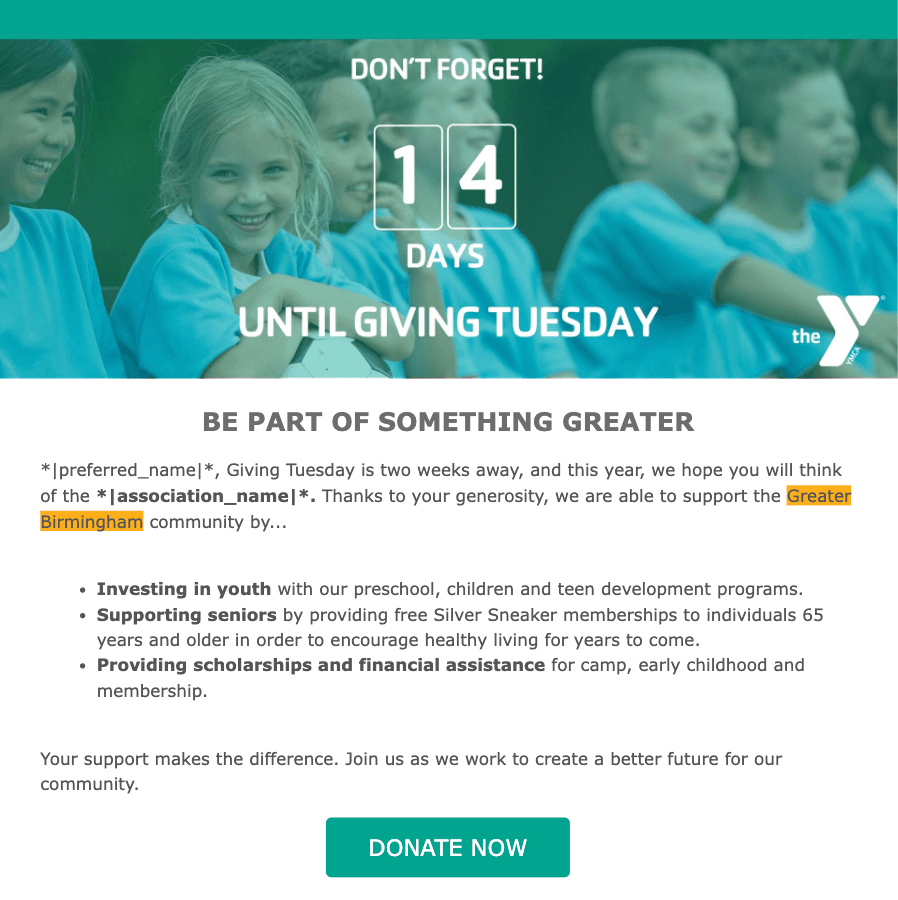
Step 1 – Preparing for Giving Tuesday
Preparation is the foundation of a successful campaign. Here’s how to set yourself up for success:
1. Define Clear Goals
Start by identifying your objectives. Are you aiming to raise a specific amount, grow your donor base, or increase community awareness? Use these goals to guide your strategy and measure success. Follow these steps to define your objectives effectively:
- Start with your “why”: Ask yourself, what is the primary purpose of this campaign? Examples could include raising a specific amount, attracting 50 new donors, or funding a particular program like youth scholarships or senior wellness initiatives.
- Break goals into categories: Consider defining goals in key areas like:
- Financial Goals: E.g., “Raise $20,000 to support 200 families.”
- Engagement Goals: E.g., “Increase website traffic by 30% on Giving Tuesday.”
- Outreach Goals: E.g., “Gain 200 new followers on Instagram.”
- Make them SMART: Ensure your goals are Specific, Measurable, Achievable, Relevant, and Time-bound. For instance, instead of saying, “We want to raise more money,” set a goal like, “We aim to raise $10,000 by 11:59 PM on November 26, 2025.”
- Document and share goals: Share your goals with your team and key stakeholders to align efforts and create accountability.
2. Craft a Compelling Story
Your story is the heart of your campaign. Showcase the impact of your programs with real-life examples, photos, and videos. Let donors see the tangible difference their contributions make. To craft a narrative that resonates:
- Identify the impact: Focus on specific programs or beneficiaries. For example, “Your donation helps provide free swim lessons to 50 underserved children in our community.”
- Highlight transformations: Share stories that show progress or change, like a senior who regained mobility through your fitness programs or a family that benefited from childcare scholarships.
- Use multimedia: Combine storytelling with visuals like photos, videos, and infographics. For example, create a short video showing the faces of the people your nonprofit has helped over the past year.
- Create urgency: Tie the story to Giving Tuesday by emphasizing the immediate impact of donations. For example, “Every $10 donated today will help feed a family of four this holiday season.”
3. Recruit Your Staff
Your staff and frontline team members are often your best ambassadors—sometimes without even realizing it. Every staff member, not just your development or leadership team, can play a role in identifying and cultivating donor relationships.
Share the Big Picture
- Clearly communicate your end-of-year fundraising goals and why they matter. For example, “Our goal is to raise $25,000 on Giving Tuesday to expand our after-school program to 100 more children.”
- Link these goals back to your mission so staff see the direct impact on the community.
Train Staff to Spot Donor Cues
From front desk staff to program instructors, anyone who interacts with members can recognize potential donor interest. Teach your team to listen for:
- Expressions of passion or enthusiasm for your mission. Example: “I love what this organization does for our community. It’s inspiring to see the impact you’re making.”
- Questions about getting more involved or offering support. Example: “How can I help out or get more involved with your events and programs?”
- Personal connections to the cause. Example: “My family has benefited so much from these services. It’s such a great resource for us.”
Encourage staff to capture and pass along these cues to your development team so you can follow up in a timely and meaningful way.
Empower Staff with Conversation Starters
Provide simple, non-intrusive prompts they can use when they hear interest:
- “That’s so wonderful to hear — have you ever considered supporting us on Giving Tuesday?”
- “We have an exciting fundraising campaign coming up; I can connect you with more information.”
Recognize and Celebrate Staff Contributions
When a staff member’s interaction leads to a donation or new supporter, acknowledge their role. This reinforces the importance of their involvement and motivates continued engagement.
4. Leverage Technology
Technology streamlines campaign management, communication, and donor tracking. Platforms like Daxko Engage simplify the process with features like:
- Pre-built templates: Use Giving Tuesday templates to create professional email campaigns, countdowns, and reminders in minutes.
- Donor segmentation: Segment your audience by donor history, demographics, or interests to send personalized messages. For example:
- For recurring donors: “Thank you for your ongoing support! This Giving Tuesday, your donation goes even further.”
- For new prospects: “Join our community this Giving Tuesday to make a difference.”
- Campaign analytics: Monitor performance metrics in real-time to adjust strategies mid-campaign. Keep track of email open rates, website clicks, and donation spikes to see what resonates most.
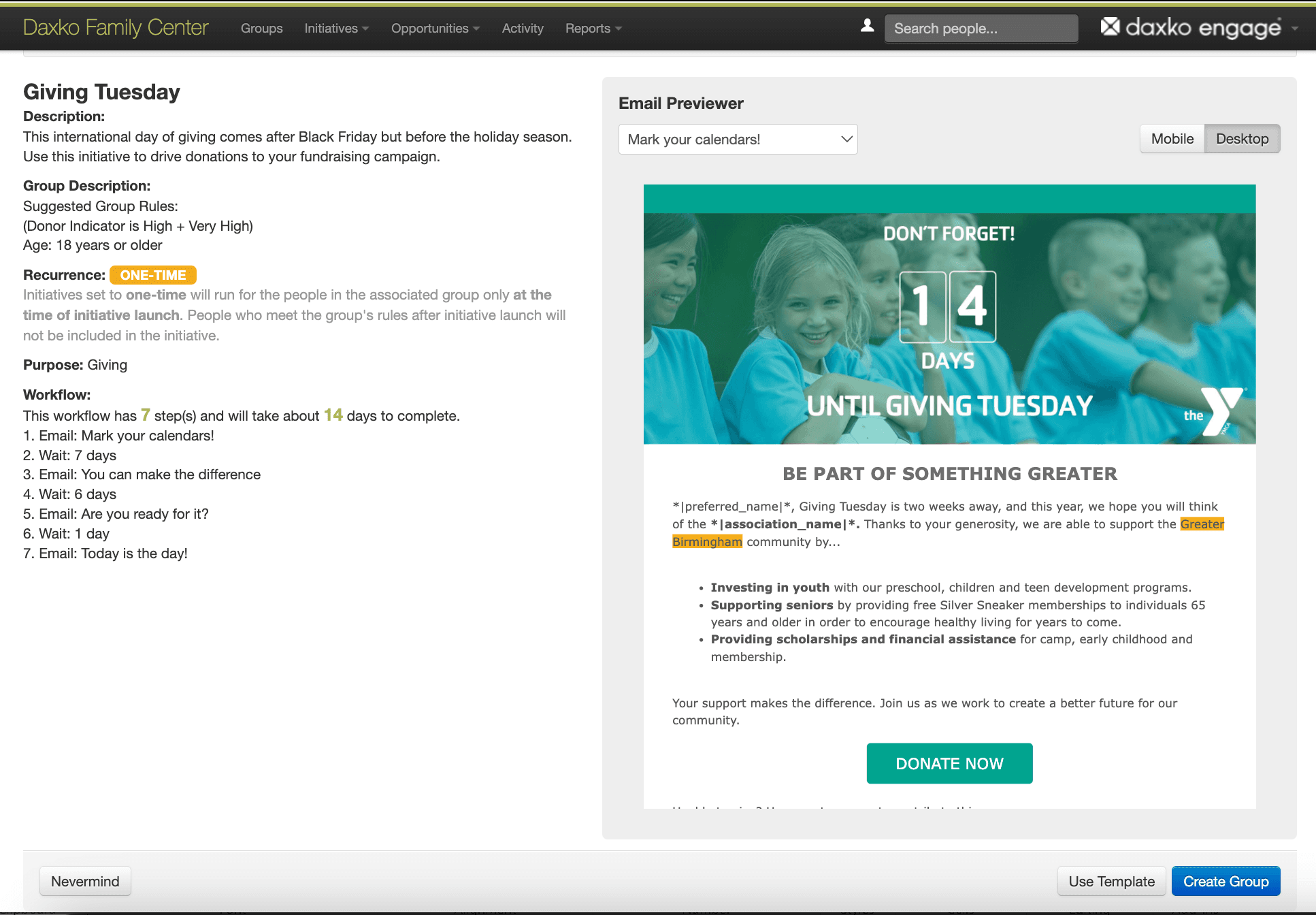
5. Activate Your Network
Engage your board, volunteers, and community members. Encourage them to share your campaign on social media, expanding your reach to new audiences. Mobilize them with these strategies:
- Create a shareable toolkit: Provide branded graphics, pre-written social media posts, and email templates so they can easily spread the word.
- Host a kickoff event: Organize a virtual or in-person kickoff to energize your team and volunteers. Use it as an opportunity to share goals and encourage personal outreach.
- Encourage peer-to-peer fundraising: Empower supporters to create their own fundraising pages and reach out to their personal networks.
- Incentivize sharing: Offer small rewards like shout-outs or branded merchandise for those who actively promote your campaign.
Step 2 – Running a Successful Campaign
On Giving Tuesday, effective execution can mean the difference between a good campaign and an exceptional one. By optimizing your online presence, leveraging social media, and engaging donors in real time, you can maximize your impact. Here’s how:
1. Optimize Your Online Presence
Your website is the hub of your Giving Tuesday campaign, and it must be ready to handle increased traffic while providing a seamless donor experience. Here’s how to optimize it effectively:
Streamline your donation process:
- Ensure your donation page is easy to navigate, with minimal steps required to complete a contribution.
- Include suggested giving amounts with clear explanations of their impact (e.g., “A $50 donation funds school supplies for one child”).
- Provide multiple payment options, including credit cards, digital wallets, and ACH transfers.
Create prominent calls to action (CTAs):
- Use eye-catching buttons like “Donate Now” or “Support Our Mission Today.”
- Place CTAs strategically across your site—on your homepage, program pages, and blog posts.
Optimize for mobile users:
- Test your site on various devices to ensure donation forms load quickly and function properly.
- Consider using a mobile-first design since a significant portion of online giving happens via smartphones.
Test your website’s performance:
- Run load tests to ensure it can handle traffic spikes.
- Check for broken links or outdated content and update as needed.
2. Use Social Media Strategically
Social media is a powerful tool for amplifying your message and engaging supporters. Here’s how to make the most of it:
Plan your content in advance:
- Create a schedule with posts leading up to, during, and after Giving Tuesday.
- Mix content types — share impact stories, behind-the-scenes photos, infographics, and short videos.
- Use hashtags like #GivingTuesday and create a branded hashtag for your campaign to increase visibility.
Highlight donor testimonials:
- Post quotes or short videos from previous donors about why they support your organization.
- Pair testimonials with visuals to make the posts more engaging.
Host live events or challenges:
- Use Instagram or Facebook Live to share updates, showcase beneficiaries, or conduct Q&A sessions with your team.
- Create interactive challenges, like matching donations for a specific timeframe, to encourage participation.
Engage with your audience:
- Respond to comments, thank donors publicly, and share posts from supporters who use your campaign hashtag.
3. Engage Donors in Real Time
Real-time engagement keeps your donors motivated and creates a sense of community during the campaign. Here’s how to stay connected:
Leverage email campaigns:
- Schedule emails at key points during the day, such as a morning reminder, a midday progress update, and an evening “last chance” message.
- Personalize your emails by addressing donors by name and referencing past contributions.
Use text messaging:
- Send timely reminders with donation links or updates on your progress. For example: “We’re halfway to our $20,000 goal! Help us get there by donating now!”
- Keep texts short and direct, ensuring they include a clear call to action.
Provide live updates:
- Use your website, social media, or email to share real-time progress, such as reaching specific milestones or announcing matching gift challenges.
- Include visuals, like a fundraising thermometer, to visually represent progress.
Celebrate successes as they happen:
- Publicly thank donors throughout the day by tagging them on social media (if they’re comfortable with it).
- Share updates like “Thanks to your generosity, we’ve reached $10,000—and we’re just getting started!”
Step 3 – Following Up and Planning for 2025
After the campaign ends, your work isn’t over. Follow-up is critical to maintaining donor relationships and setting the stage for future success.
1. Thank Your Donors
Expressing gratitude is non-negotiable. Send personalized thank-you messages via email, social media, or even handwritten notes. Highlight how their contributions made an impact.
2. Analyze Campaign Performance
Review your results to identify what worked and what didn’t. Daxko Engage’s campaign tracking features help you analyze donor behavior, campaign ROI, and engagement metrics.
3. Build Long-Term Relationships
Use the momentum from Giving Tuesday to nurture donor relationships. Share regular updates, invite donors to events, and involve them in your mission throughout the year.
Giving Tuesday Ideas to Boost Engagement
Need inspiration? Here are a few ideas to energize your campaign:
1. Social Media Challenges
Encourage your followers to participate in interactive challenges that promote your cause and expand your reach.
- “Why I Give” Campaign: Ask supporters to share personal stories or reasons for donating, using a unique hashtag. This fosters a sense of community and personal connection to your mission. Example: A nonprofit could launch a #WhyIGive campaign, prompting donors to post their stories on social media, thereby encouraging others to participate.
- Acts of Kindness Challenge: Inspired by initiatives like #FeedTheDeed, encourage individuals to perform and share random acts of kindness, nominating friends to do the same. This creates a ripple effect of generosity. Example: A community center might start a challenge where participants share videos of their acts of kindness, tagging others to continue the chain.
2. Matching Gifts
Partner with businesses or major donors to match contributions, effectively doubling the impact of each donation.
- Corporate Partnerships: Collaborate with local businesses to match donations up to a certain amount, incentivizing donors to give more. Example: World Vision partnered with Thirty-One Gifts, matching each donation with products of equal value, thereby doubling the impact.
- Individual Donor Matches: Engage major donors to pledge matching funds, creating a sense of urgency and amplifying contributions. Example: A family foundation offers to match donations dollar-for-dollar up to $50,000, encouraging the community to maximize the opportunity.
3. Impact Milestones
Share real-time updates as you reach fundraising goals to maintain momentum and donor engagement.
- Progress Thermometer: Display a visual representation of funds raised, updating it regularly to show progress toward your goal. Example: An organization uses a fundraising thermometer graphic on their website and social media, celebrating each milestone achieved.
- Donor Recognition: Publicly acknowledge donors as certain milestones are met, fostering a sense of community and appreciation. Example: Posting thank-you messages on social media for every 50 donors, highlighting their contributions and impact.
Start Preparing Today
With this toolkit, you have the strategies and tools to make Giving Tuesday your most successful campaign yet.
Ready to take your efforts to the next level? Download The Nonprofit Marketer’s Guide to Community Outreach for more tips and best practices.

The Nonprofit Marketer’s Guide to Community Outreach
Today’s community members are tech-savvy. Learn how to capture their attention online (and keep it).
- Instant Insights
- Time-Saving Tools
- ChatGPT Prompts Customized for Nonprofits
Subscribe to our blog
Curated trends and resources, right to your inbox.
